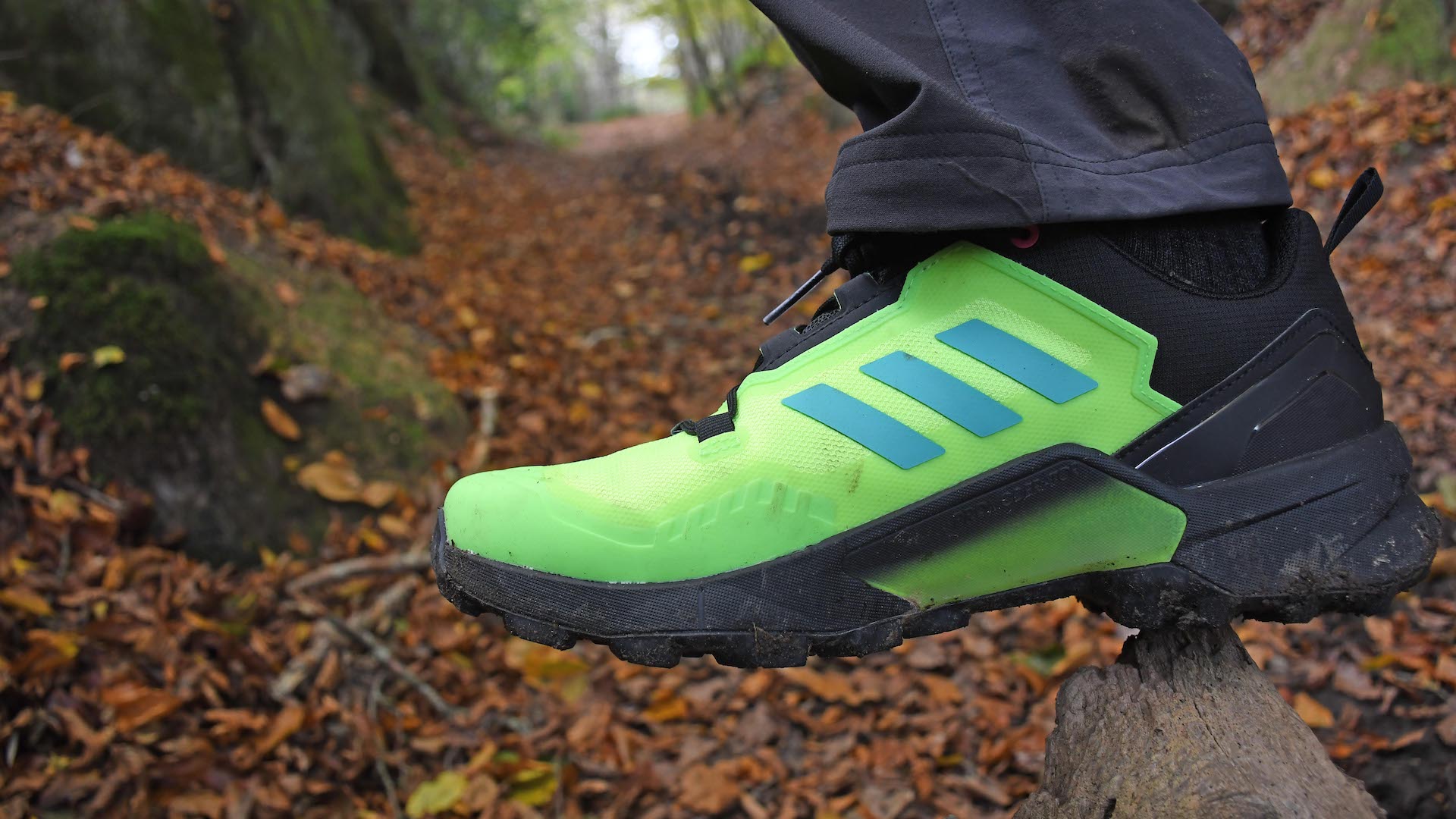Advnture Verdict
If you’re looking for a high-performance hiking shoe that looks more like a sporty trainer, then the Swift R3s have got your name written all over them.
Pros
- +
Technically capable
- +
Great grip
- +
Sleek look
- +
Lots of color options
Cons
- -
Over-featured and too rigid for casual walkers
- -
Some colorways a little lurid
You can trust Advnture
Adidas Terrex Swift R3 GTX: first impressions
High-end hiking shoes disguised as street-smart trainers, the Adidas Terrex Swift R3 GTX are available in six different colorways, ranging from the frankly lurid acid mint and solar yellow option (which we tested) through to the far cooler and more discreet black version (which you can see in our best hiking shoes buying guide).
These shoes are armed with a formidable set of features that make them very trail capable while still having the appearance of a shoe you could happily kick a football around in.
The Continental outsole has a set of terrain-hugging 4.5mm lugs, cleverly designed and positioned to provide push-off traction from the toe and braking capability on the tapered heel when you’re descending, with reverse chevrons dishing up good levels of control.
Despite their sleek appearance, there is a substantial toecap and heel cup, and a rand that encircles the shoe. They also have a protection plate in the outsole, to stop sharp sticks and stones sticking through and hurting your feet.
The EVA midsole supplies cushioning but the Swift R3s are surprisingly rigid, courtesy of the chunky ‘pro-moderator’ feature in the midfoot, designed to improve lateral stability and prevent arch fatigue on bigger walks. Some hikers will love this feature, especially those who tend to do longer walks and tackle rocky and sometimes technical terrain, while others may find them a little unyielding for shorter walks.
• RRP: $150 (US) / £130 (UK)
• Gender specificity: Men’s / Women’s
• Materials: Gore-Tex textile upper; water-resistant and breathable lightstrike EVA midsole; textile lining; molded sockliner; Continental rubber outsole
• Weight (average, per shoe): 440g / 15.5oz
• Colors: Core Black, Grey Three & Solar Red / Core Black, Grey One & Solar Yellow / Signal Green, Acid Mint & Solar Yellow / Beige Tone, Pulse Yellow & Core Black / Legend Ink, Orbit Violet & Bold Blue / Focus Olive, Core Black & Grey Five
• Compatibility: Best for tackling trails fast

Adidas Terrex Swift R3 GTX: on the trail
The really surprising thing about these shoes is how rigid they are, especially after giving the impression that they’re going to be more flexible. This isn’t a criticism – it gives them good capability on rocky peaks and more technical terrain, but it won’t suit those who do more casual walks, who might prefer a more relaxed feel.
Overall I was really impressed with these shoes (more than I expected to be, if I’m honest, judging by the way they present). They performed really well on several quick-paced hikes in very wet conditions. They kept my feet dry, allowed them to breath and the grip on the outsoles was decent, with good levels of control during muddy descents.
All the latest inspiration, tips and guides to help you plan your next Advnture!
The rigidity across the length of the shoe was good when clambering up rocks, and the midsole supplied adequate cushioning for a comfortable ride. The lacing system, which includes extra coverage across the top of the toes and features a higher lace hole at the top so you don’t risk losing a shoe in deep claggy mud, was also very good. Between this, the heel cap and the sockliner, the fit is really secure and your feet do not move a millimeter once you’re laced in.
I found the fit a little tight across the balls of my feet, but I have horribly wide hobbit feet – other users have said there is too much wriggle room in the toebox, but I definitely didn’t find this. On balance, I would advise people to order the size they take in their best trail running shoes, rather than going up half a size as is often recommended for hiking boots.
The appearance is a little plasticy, and the pair I have been trail testing are the most lairy of all the colorways available and wouldn’t be my choice of look for a hiking shoe, but there are far more outdoor-sympathetic and cooler colors available.
For hikes when you want to move quickly across technical terrain, and fastpacking adventures in general, I would happily recommend these shoes. I’ve done around 60km in them so far, and there’s no sign of any wear and tear (as you’d expect from a premium-priced product) but the construction seems reliably robust and I expect to get many hundreds of kilometers out of them.

Author of Caving, Canyoning, Coasteering…, a recently released book about all kinds of outdoor adventures around Britain, Pat has spent 20 years pursuing stories involving boots, bikes, boats, beers and bruises. En route he’s canoed Canada’s Yukon River, climbed Mont Blanc and Kilimanjaro, skied and mountain biked through the Norwegian Alps, run an ultra across the roof of Mauritius, and set short-lived records for trail-running Australia’s highest peaks and New Zealand’s Great Walks. He’s authored walking guides to Devon and Dorset, and once wrote a whole book about Toilets for Lonely Planet. Follow Pat’s escapades on Strava here and Instagram here.

